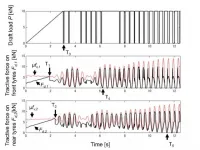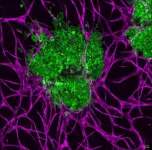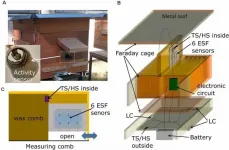(Press-News.org) Scientists have shed light on why some people who have a stroke do not also have abnormal heart rhythms, even though their hearts contain similar scar tissue.
Their results, published today in eLife, could help identify the best treatments for people who might be at risk of recurrent stroke, new heart disorders, or both.
Strokes are often caused by abnormal blood flow resulting from rapid, irregular beating in the upper chamber of the heart. This is also called atrial fibrillation (AFib). But some people have strokes that appear to have been caused by the heart, yet there is no evidence of AFib. In fact, around 25% of strokes fall into this group - called embolic strokes of undetermined source (ESUS).
"The absence of rhythm disorders in these people is confusing because we know that both atrial fibrillation and ESUS are associated with the build-up of a similar level of scar tissue in the heart," explains first author Savannah Bifulco, a graduate student at the Department of Bioengineering, University of Washington, Seattle, US. "We wanted to test whether there is some fundamental difference in the scar tissue between these two groups of patients that might explain why AFib patients suffer from rhythm disorders but ESUS patients do not."
The team developed 90 computer-based models using magnetic resonance imaging (MRI) scans from patients: 45 models were derived from patients who had a stroke of undetermined source and 45 from those who had AFib and had not yet received treatment. They compared the amount and location of the scar tissue in the upper-left heart chamber across all samples and then used simulations to test whether it was still possible to trigger an abnormal heart rhythm.
"Using real patient MRIs, we created computerised models of the hearts of patients who have had a stroke, but do not have AFib. We then ran those models through a battery of virtual stress tests we originally designed to help understand the effects of disease-related atrial changes in patients who did have AFib," explains co-senior author Patrick Boyle, Assistant Professor of Bioengineering, who leads the Cardiac Systems Simulation Lab at the University of Washington. "Interestingly, we found that models from ESUS and AFib patients were equally likely to be affected by this arrhythmia initiation protocol. This is surprising, because it suggests ESUS and AFib patients have the same proverbial tinderbox of fibrotic remodelling. We believe the implication is that these stroke patients are only missing the trigger to start the fibrillation process - the spark to light the fire."
Undetectable AFib is thought to be a potential cause of ESUS, and all people who have had a stroke of undetermined source are usually monitored for AFib and started on aspirin to prevent another stroke. If AFib is detected, stronger anti-clotting drugs would be recommended. As with all treatments, these drugs come with side effects and risks of their own, and it is important to know who really needs them. Yet only 30% of ESUS patients ever show evidence of AFib, making it impossible for clinicians to know which patients should be treated as high-risk for AFib and which ones are better with monitoring alone. Now, the team is moving towards using this modelling approach for stroke and arrhythmia risk stratification in potentially vulnerable groups.
"By using these tools of advanced imaging, computational power and outcomes data to create robust and validated computational models of arrhythmia, we're paving the way towards a better understanding and gaining valuable insights into the nature of each individual's disease course," says co-senior author Nazem Akoum, Director, Atrial Fibrillation Program, Division of Cardiology, University of Washington School of Medicine. "Our goal is to make computational modelling more integrated into how clinical decisions are made, placing what we see in simulations alongside many other factors like medical co-morbidites, diagnostic tests and family history. We want to help clinicians wring every last drop of information and insight from these images to help them paint the most complete picture possible for their patients."
INFORMATION:
For more information about the University of Washington's Cardiac Systems Simulations Lab, visit https://cardsslab.org.
Media contact
Emily Packer, Media Relations Manager
eLife
e.packer@elifesciences.org
+44 (0)1223 855373
Brian Donohue, Public Information Editor
University of Washington School of Medicine
bdonohue@uw.edu
+1 (206) 543-7856
About eLife
eLife is a non-profit organisation created by funders and led by researchers. Our mission is to accelerate discovery by operating a platform for research communication that encourages and recognises the most responsible behaviours. We aim to publish work of the highest standards and importance in all areas of biology and medicine, while exploring creative new ways to improve how research is assessed and published. eLife receives financial support and strategic guidance from the Howard Hughes Medical Institute, the Knut and Alice Wallenberg Foundation, the Max Planck Society and Wellcome. Learn more at https://elifesciences.org/about.
To read the latest Computational and Systems Biology research published in eLife, visit https://elifesciences.org/subjects/computational-systems-biology.
And for the latest in Medicine, see https://elifesciences.org/subjects/medicine.
Aachen, Germany and Hennigsdorf/Berlin, Germany, May 4, 2021 - German University Hospital Uniklinik RWTH Aachen ("Uniklinik RWTH Aachen") and diagnostics company SphingoTec GmbH ("SphingoTec") today announced that the endothelial function biomarker bio-ADM aids in the early risk stratification and management of patients suffering from severe COVID-19, in need for escalated intensive care treatment (1). A team lead by the clinical researchers at Uniklinik RWTH Aachen has shown that high bio-ADM levels indicate the severity of the acute respiratory distress ...
Tokyo, Japan - Researchers at Tokyo University of Agriculture and Technology (TUAT) modeled the dynamic instability--the so-called "power hop"--that can cause uncontrollable bouncing and damage tractors when they plow dry ground. The team found that self-excited oscillations can arise when the tractor pushes against the ground.
Plowing a field on a tractor may seem like a serene occupation, but sudden vibrations can grow unexpectedly and threaten to topple you under certain conditions. The problem is that in nonlinear systems with coupled components, as with a mechanical tractor, ...
A synthetic approach that improves absorber layers in perovskite solar cells could help them achieve their full potential and draw closer to the performance of leading gallium arsenide devices.
Solar cells that rely on perovskite thin films to capture sunlight are the fastest growing photovoltaic technology. Cheaper and easier to manufacture and incorporate into devices than conventional semiconductors, lead halide perovskites also effectively absorb visible light and display long charge carrier diffusion lengths -- an indicator of their ability to maintain light-induced electrons and holes separation and facilitate charge transport.
Performance ...
A new Boston University School of Public Health (BUSPH) study has identified for the first time how the aryl hydrocarbon receptor (AhR), an environmental chemical receptor, drives immunosuppression in oral squamous cell carcinoma (OSCC)--and that its removal from malignant cells can result in tumor rejection.
Published in the journal Proceedings of the National Academy of Sciences, the study findings provide new insight into the biology of cancer immunosuppression, and identify a new target for cancer immunotherapy treatment.
Immune checkpoint inhibitors (immunotherapy drugs) are some of the most important treatments that have emerged for treating many cancers, including OSCC. Targeting immune checkpoint molecules such as PD-1, ...
Measures to contain the Corona pandemic are the subject of politically charged debate and tend to polarize segments of the population. Those who support the measures motivate their acquaintances to follow the rules, while those who oppose them call for resistance in social media. But how exactly do politicization and social mobilization affect the incidence of infection? Researchers at the Max Planck Institute for Human Development have examined this question using the USA as an example. Their findings were published in Applied Network Science.
Limit crowds, keep a safe distance, and wear masks. Such non-pharmaceutical ...
Cancerous tumors thrive on blood, extending their roots deep into the fabric of the tissue of their host. They alter the genetics of surrounding cells and evolve to avoid the protective attacks of immune cells. Now, Penn State researchers have developed a way to study the relationship between solid, difficult-to-treat tumors and the microenvironment they create to support their growth.
The method has the potential to act as a testbed for drugs and other anticancer treatments, according to Ibrahim T. Ozbolat, associate professor of engineering science and mechanics and biomedical engineering, who led the research. The details of the approach were published in Advanced Biology.
Using ...
Despite human inventiveness and ingenuity, we still lag far behind the elegant and efficient solutions forged by nature over millions of years of evolution.
This also applies for buildings, where animals and plants, have developed extremely effective digging methods, for example, that are far more energy-efficient than modern tunnelling machines, and even self-repairing foundations that are unusually resistant to erosion and earthquakes (yep, we're talking about roots here).
Researchers from all over the world are therefore seeking inspiration in nature to develop the buildings of the future, and researchers from Aarhus University ...
Honeybees have a complex communication system. Between buzzes and body movements, they can direct hive mates to food sources, signal danger, and prepare for swarming - all indicators of colony health. And now, researchers are listening in.
Scientists based in Germany - with collaborators in China and Norway - have developed a way to monitor the electrostatic signals that bees give off. Basically, their wax-covered bodies charge up with electrostatic energy due to friction when flying, similar to how rubbing your hair can make it stand on end. That energy then gets emitted during communications.
"We were thrilled by the ...
The majority of top-rated fertility apps collect and even share intimate data without the users' knowledge or permission, a collaborative study by Newcastle University and Umea University has found.
Researchers are now calling for a tightening of the categorisation of these apps by platforms to protect women from intimate and deeply personal information being exploited and sold.
For hundreds of millions of women fertility tracking applications offer an affordable solution when trying to conceive or manage their pregnancy. But as this technology grows in popularity, experts have revealed that most of the top-rated fertility apps collect and share sensitive ...
T-cell acute lymphoblastic leukemia (T-ALL) is a very aggressive type of blood cancer. It is relatively rare but still draws a lot of attention as it mostly develops in children under the age of 20. The standard treatment for T-ALL involves heavy chemotherapy procedures, which result in favorable outcomes with an overall survival of 75% after 5 years.
However, some patients do not respond to this treatment, or they only respond for a short period, after which the disease grows back. These patients therefore need alternative therapies.
Researchers from the Faculty of Health and Medical Sciences, University of Copenhagen, have now identified a combination treatment, which could potentially benefit patients ...


